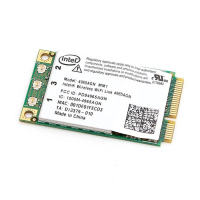NOTE: Intel PROSet/Wireless security features on Windows Vista
support TTLS and EAP-SIM authentication only.
WPA or WPA2
Wi-Fi Protected Access (WPA or WPA2) is a security enhancement that strongly
increases the level of data protection and access control to a wireless network. WPA
enforces 802.1x authentication and key-exchange and only works with dynamic
encryption keys. To strengthen data encryption, WPA utilizes its Temporal Key
Integrity Protocol (TKIP). TKIP provides important data encryption enhancements
that include a per-packet key mixing function, a message integrity check (MIC)
called Michael an extended initialization vector (IV) with sequencing rules, and a
rekeying mechanism. With these enhancements, TKIP protects against WEP's known
weaknesses.
The second generation of WPA that complies with the IEEE TGi specification is
known as WPA2.
Enterprise Mode: Enterprise Mode verifies network users through a RADIUS or
other authentication server. WPA utilizes 128-bit encryption keys and dynamic
session keys to ensure your wireless network's privacy and enterprise security.
Enterprise Mode is targeted to corporate or government environments.
Personal Mode: Personal Mode requires manual configuration of a pre-shared key
(PSK) on the access point and clients. PSK authenticates users via a password, or
identifying code, on both the client station and the access point. No authentication
server is needed. Personal Mode is targeted to home and small business
environments.
WPA-Enterprise and WPA2-Enterprise: Provide this level of security on
enterprise networks with an 802.1x RADIUS server. An authentication type is
selected to match the authentication protocol of the 802.1x server.
NOTE: WPA-Enterprise and WPA2-Enterprise are interoperable.
WPA-Personal and WPA2-Personal: Provide this level of security in the small
network or home environment. It uses a password also called a pre-shared key
(PSK). The longer the password, the stronger the security of the wireless network. If
your wireless access point or router supports WPA-Personal and WPA2-Personal then
you should enable it on the access point and provide a long, strong password. The
same password entered into access point needs to be used on this computer and all
other wireless devices that access the wireless network.

